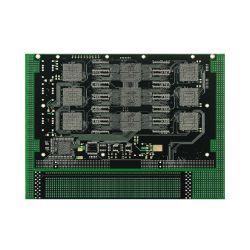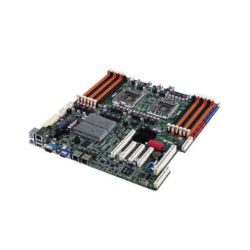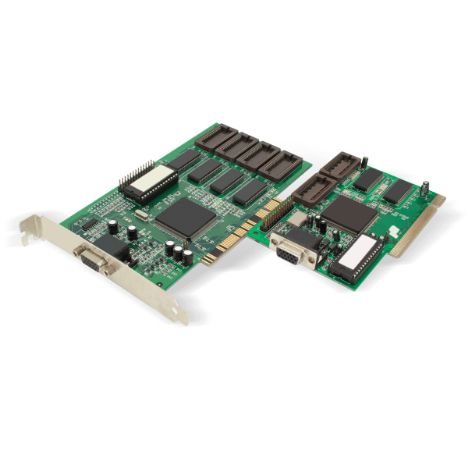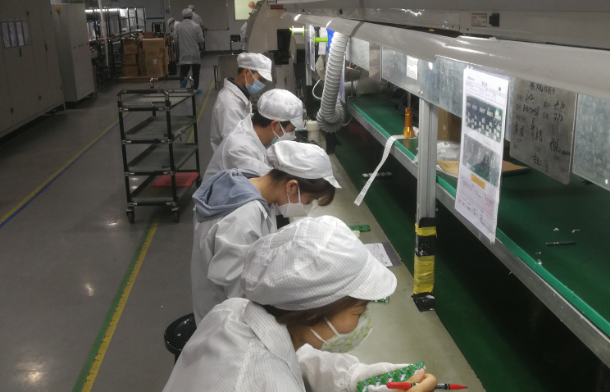What is SMT chip processing?
SMT chip processing is a method of assembling electronic circuits by placing surface mount components (e.g., chips, resistors, capacitors, etc.) onto the surface of a printed circuit board (PCB) and soldering them in place. The components are typically small, and the soldering process is done using a specialized machine called a pick and place machine, which places the components onto the PCB with high precision.
How is SMT chip processing different from through-hole technology?
Through-hole technology is another method of assembling electronic circuits, in which components are inserted into holes on a PCB and soldered in place. In contrast, SMT chip processing involves placing components on the surface of the PCB rather than inserting them into holes. SMT components are generally smaller and more densely packed than through-hole components, which makes them more suitable for use in smaller, more compact electronic devices.
What are the advantages of SMT chip processing?
here are several advantages to using SMT chip processing:
SMT components are smaller and more densely packed than through-hole components, which allows for the creation of smaller and more compact electronic devices.
SMT chip processing is faster and more efficient than through-hole technology, as the pick and place machine can place multiple components at once with high precision.
SMT components are more resistant to vibration and shock than through-hole components, which makes them more suitable for use in rugged or mobile applications.
What are the challenges of SMT chip processing?
There are several challenges associated with SMT chip processing:
SMT components are much smaller than through-hole components, which makes them more difficult to handle and place onto the PCB.
The soldering process for SMT components requires specialized equipment and techniques, which can be difficult to master.
SMT chip processing is more sensitive to contaminants and defects, as even small amounts of dust or other contaminants can affect the quality of the soldering process.
What equipment is used in SMT chip processing?
There are several pieces of equipment that are commonly used in SMT chip processing:
Pick and place machine: A machine that places components onto the PCB with high precision
Reflow oven: A machine that heats the PCB and components to a high temperature, melting the solder and causing it to flow around the components, forming a strong connection.
Solder paste stencil: A thin sheet of metal with holes cut into it that is used to apply a precise amount of solder paste to the PCB.
Solder paste: A thick, pasty mixture of solder and flux that is used to hold components in place and facilitate the soldering process.
What is the process of SMT chip processing?
The process of SMT chip processing typically involves the following steps:
Preparation: Before the soldering process begins, the PCB is cleaned and prepared to ensure that it is ready for the placement of components and the soldering process. This typically involves cleaning the PCB using a solvent or a specialized cleaning solution to remove any dirt, dust, or contaminants that may be present on its surface, and treating the PCB with a flux to facilitate the soldering process.
Printing: During the printing process, a thin sheet of metal called a solder paste stencil is used to apply a precise amount of solder paste to the PCB. The stencil has a pattern of holes cut into it that corresponds to the placement of the components on the PCB. The stencil is placed over the PCB, and a thin layer of solder paste is applied to the stencil using a squeegee or similar tool. The solder paste flows through the holes in the stencil and onto the PCB, forming a pattern that corresponds to the placement of the components.
Placement: The pick and place machine is used to accurately place the components onto the PCB in the correct positions. The machine uses a series of robotic arms and vision systems to pick up and place the components onto the PCB with high precision. The machine is programmed with the correct placement coordinates for each component, and it uses its vision systems to locate the correct positions on the PCB.
Reflow: During the reflow process, the PCB and components are placed in a specialized oven called a reflow oven. The oven heats the PCB and components to a high temperature, typically between 180 and 260 degrees Celsius, depending on the type of solder being used. As the temperature increases, the solder paste on the PCB begins to melt and flow around the components, forming a strong connection between the components and the PCB. The temperature is carefully controlled during the reflow process to ensure that the solder flows properly and forms a reliable connection without damaging the components or the PCB.
Inspection: After the reflow process is complete, the PCB is cooled and removed from the oven. The soldered joints are then inspected to ensure that they are properly formed and that all components are correctly placed and soldered. This is typically done using a combination of automated and manual inspection methods, such as visual inspection, x-ray inspection, and automated optical inspection (AOI). Any defects that are detected during inspection can be corrected by reworking the PCB, which involves removing and resoldering the faulty components.
Preparation: The PCB is cleaned and prepared for the soldering process.
Yes, preparation is an important step in the SMT chip processing process. Before the soldering process begins, the PCB must be cleaned and prepared to ensure that it is ready for the placement of components and the soldering process.
The PCB is typically cleaned using a solvent or a specialized cleaning solution to remove any dirt, dust, or contaminants that may be present on its surface. This is important, as even small amounts of contaminants can affect the quality of the soldering process and lead to defects in the finished product.
The PCB may also be treated with a flux, which is a chemical agent that helps to remove oxides and other contaminants from the surface of the PCB and the components. Flux also helps to facilitate the soldering process by reducing the surface tension of the molten solder and helping it to flow more easily.
After the PCB has been cleaned and prepared, it is ready for the printing and placement of components, as well as the reflow process. Any defects or contaminants that are present on the PCB can be detected during the inspection process and corrected by reworking the PCB, which involves removing and resoldering the faulty components.
Printing: Solder paste is applied to the PCB using a solder paste stencil.
Yes, the printing process is an important step in SMT chip processing. During the printing process, a thin sheet of metal called a solder paste stencil is used to apply a precise amount of solder paste to the PCB.
The solder paste stencil has a pattern of holes cut into it that corresponds to the placement of the components on the PCB. The stencil is placed over the PCB, and a thin layer of solder paste is applied to the stencil using a squeegee or similar tool. The solder paste flows through the holes in the stencil and onto the PCB, forming a pattern that corresponds to the placement of the components.
The printing process is critical for ensuring that the correct amount of solder paste is applied to the PCB and that it is applied in the correct locations. Any defects in the solder paste application, such as excess or insufficient solder, can be detected during the inspection process and corrected by reworking the PCB, which involves removing and resoldering the faulty components.
Placement: The pick and place machine places the components onto the PCB in the correct positions.
Yes, the placement process is an important step in SMT chip processing. During the placement process, a specialized machine called a pick and place machine is used to accurately place the components onto the PCB in the correct positions.
The pick and place machine uses a series of robotic arms and vision systems to pick up and place the components onto the PCB with high precision. The machine is programmed with the correct placement coordinates for each component, and it uses its vision systems to locate the correct positions on the PCB.
The pick and place machine is a key piece of equipment in the SMT chip processing process, as it allows for high-precision placement of the components onto the PCB. This is critical for ensuring that the finished product is of high quality and reliability. Any defects in component placement can be detected during the inspection process and corrected by reworking the PCB, which involves removing and resoldering the faulty components.
Reflow: The PCB and components are placed in a reflow oven, where they are heated to a high temperature, melting the solder and causing it to flow around the components.
Yes, the reflow process is an important step in SMT chip processing. During the reflow process, the PCB and components are placed in a specialized oven called a reflow oven. The oven heats the PCB and components to a high temperature, typically between 180 and 260 degrees Celsius, depending on the type of solder being used.
As the temperature increases, the solder paste on the PCB begins to melt and flow around the components, forming a strong connection between the components and the PCB. The temperature is carefully controlled during the reflow process to ensure that the solder flows properly and forms a reliable connection without damaging the components or the PCB.
After the reflow process is complete, the PCB is cooled and removed from the oven. The soldered joints are then inspected to ensure that they are properly formed and that all components are correctly placed and soldered. Any defects that are detected during inspection can be corrected by reworking the PCB, which involves removing and resoldering the faulty components.
Inspection: The completed PCB is inspected to ensure that all components are correctly placed and soldered.
Yes, inspection is an important step in the SMT chip processing process. After the reflow process, the completed PCB is inspected to ensure that all components are correctly placed and soldered. This is typically done using a combination of automated and manual inspection methods, such as visual inspection, x-ray inspection, and automated optical inspection (AOI).
During visual inspection, a technician uses a magnifying glass or microscope to examine the PCB for defects such as misalignment, solder balls, and excess or insufficient solder. X-ray inspection involves using a specialized x-ray machine to examine the PCB for defects that are not visible to the naked eye, such as solder voids and misaligned components. Automated optical inspection (AOI) uses cameras and computer software to automatically scan the PCB for defects, allowing for faster and more accurate inspection than manual methods.
The inspection process is critical for ensuring the quality and reliability of the finished product. Any defects that are detected during inspection can be corrected by reworking the PCB, which involves removing and resoldering the faulty components.
What are some common defects in SMT chip processing
Solder bridges: This occurs when two adjacent pads or components are connected by a blob of excess solder.
Solder balls: These are small balls of excess solder that form on the surface of the PCB.
Open circuits: This occurs when a component is not properly soldered to the PCB, resulting in an open circuit.
Shorts: This occurs when two components or pads are accidentally soldered together, resulting in a short circuit.
Misalignment: This occurs when a component is not placed correctly on the PCB, resulting in an incorrect or faulty connection.
Solder voids: These are small areas within the soldered joint that are not filled with solder, resulting in a weak connection.
Insufficient solder: This occurs when there is not enough solder on the PCB, resulting in a weak or unreliable connection.
Excess solder: This occurs when there is too much solder on the PCB, resulting in a messy or unreliable connection.
These defects can be caused by a variety of factors, including faulty equipment, incorrect solder paste application, or operator error. They can be detected and corrected during the inspection process, or they can be prevented by following proper procedures and using high-quality materials and equipment.






Prototype orders placed within 24 hours
Normal lead time (5-7 Working days for some PCBs prototypes and small batch production)
Faster lead time (48 hours for some PCBs prototypes and small batch production)





